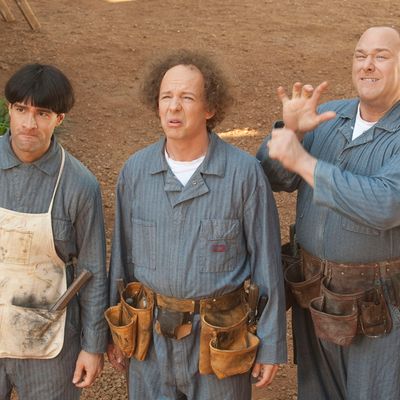
There were a few moments in the Three Stooges showing I attended during which the generally festive audience became unnerved. The one I remember most prominently: when Moe held Curly* down and spent several seconds sawing on his forehead with a cheese grater. That actor Will SassoÔÇÖs face had not actually been turned into a bloody horror show didnÔÇÖt seem to make the people around me any less disturbed. Their reaction says something about the modern slapstick viewer: Even while watching something thatÔÇÖs not real, the audience is thinking about real consequences. TheyÔÇÖre so used to seeing gonzo stunts induce legitimate ÔÇö but temporary ÔÇö suffering that they canÔÇÖt help but consider what it would actually be like to have their face shredded. Even fake violence, in this age, has to walk the line between amusing recklessness and disturbing sadism.
AmericaÔÇÖs Funniest Home Videos launched our era of slapstick realism. Its overuse of sound effects and idiot Bob Saget punchlines kept it from true greatness, but its combination of crowdsourcing and beleaguered gonads was prescient and ingenious. Cartoon violence had become boringly, predictably ridiculous, a point the Simpsons was making contemporaneously via the parodic, absurdly over-the-top Itchy and Scratchy show-within-a-show, whose characters were always springing back to life after gruesome decapitation, disembowlment, radiation poisoning, etc. AmericaÔÇÖs Funniest Home Videos presented a counterpoint to these transparently unnatural cartoon tropes: real fallout from mundane accidents. I recall a lot of brides tripping on wedding dresses and dudes getting nailed in the grill by wiffle balls. If AFHV could be summed up in a word, it would be┬áoof. But the protagonists of the most ridiculous videos always showed up in the studio smiling and laughing. They were okay!
AFHVÔÇÖs successor, of course, was Jackass, the Johnny KnoxvilleÔÇôstarring vehicle of next-generation comic-violent realism. It applied the scientific method to Funniest Home VideoÔÇôstyle premises, its stars creating the conditions for others (and themselves) to be unpleasantly surprised. This built-in predictability required an amping up of consequences: Since the whole point of physical comedy is that you shouldnÔÇÖt know exactly whatÔÇÖs coming, Jackass victims had to be abused either in an ambush (the giant fist knocking down unsuspecting dudes in a hallway) or by being given a task so ridiculous it was almost guaranteed to fail in a brutal way (attaching a rocket engine to a bicycle) or just doing something so horribly self-inflictive that the outcome you see coming still makes you jump (being bitten on the penis by an angry snake).
Since its subjects were real, JackassÔÇÖs experiments did have their limits. You wanted them to walk away with a few bruises ÔÇö gnarly ones shown in X-treme closeup ÔÇö but not a compound femoral fracture and severe brain damage. ÔÇ£Guy chasing a roadrunner accidentally falls off a cliff and breaks his pelvisÔÇØ would not be a good Jackass bit. The show became so popular that its trope of horrible but nondisabling physical pain found its way into fictional slapstick as well: Zach Galifianakis getting Tased in The Hangover; Will Ferrell getting shot with a tranquilizer in Old School; Chris Pratt running at full speed into the side of an ambulance in Parks and Recreation. Into this environment stepped the Farrelly brothersÔÇÖ anachronistically faithful Stooges revival, in which no amount of extreme physical impact causes visible damage. Thus the Stooges jokes that went over best with the modern audience came across as Jackass or PrattÔÇôstyle playful bonking: Even when the characters were getting hit in the face or taken out by a falling object, the relatively low speed of the impacts and the actorsÔÇÖ nonchalant reactions read reassuringly as oof rather than [devastating spinal injury]. Maybe IÔÇÖm projecting my own squeamishness here, but it seemed like gags involving cutting implements and explosions and long falls were less successful with the crowd.
Odd as it sounds, the Jackass genre could learn some sophistication from Stooges. The movieÔÇÖs physical-comedy highlights were sequences of clever choreography ÔÇö sort of miniplots in which an object swings off-screen for juuuust long enough to surprise you when it swings back to knock a character in the back of the head, causing them to drop a brick on their own toe and then hop one-legged backwards into a vat of yogurt thatÔÇÖs being loaded onto a plane to Abu Dhabi. (Abu Dhabi: classic slapstick package destination.) If some brilliantly stupid teenagers out there can figure out how to organize a series of YouTube stunt collisions with the elegance of an old-fashioned routine, the evolution of slapstick might accelerate once more. (Directly into the side of a tree, one hopes.)
*The original version of this post stated that Moe held Larry down.

